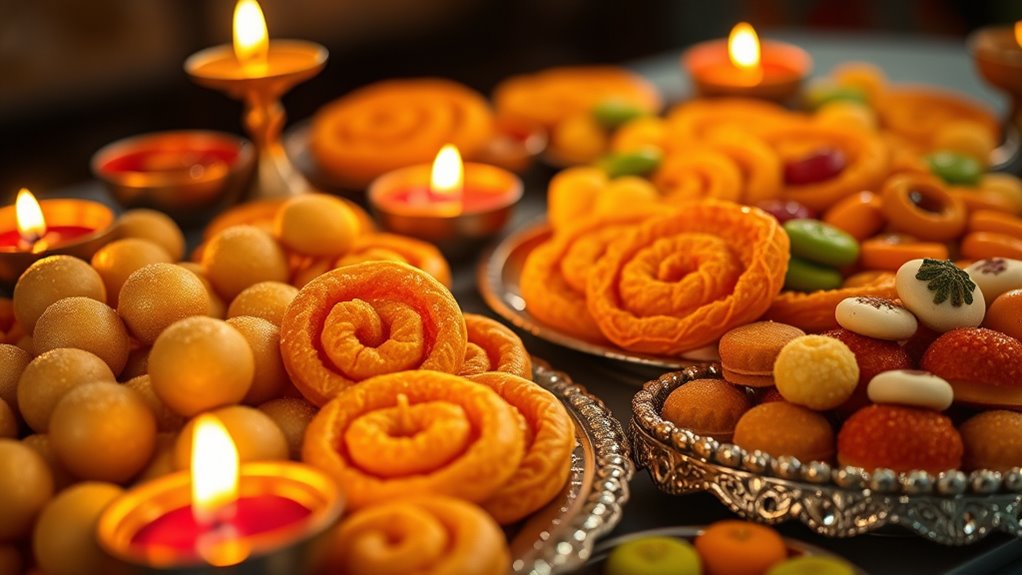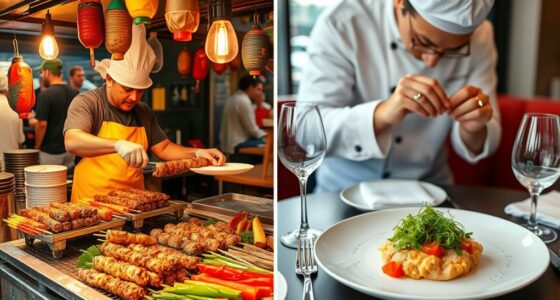During Diwali, you enjoy a vibrant array of sweets like Gulab Jamun, Kaju Katli, and Gajar Ka Halwa, often flavored with saffron and cardamom. Regional specialties add local flair, from South Indian payasam to North Indian pedas. To make celebrations special, you can prepare nutritious treats by using dry fruits and natural sweeteners and present them beautifully with festive packaging. Keep exploring to discover more tips and creative ideas to elevate your Diwali feasts.
Key Takeaways
- Diwali sweets predominantly feature ingredients like milk, ghee, nuts, and regional specialties, highlighting traditional culinary heritage.
- Nutritious variations incorporate dry fruits, jaggery, and natural sweeteners, emphasizing health-conscious preparations.
- Sweets are paired with savory snacks, stored in airtight containers, and presented with festive decoration for visual appeal.
- Modern twists include fusion desserts and innovative formats like cakes, truffles, and trendy visual presentations.
- Combining tradition with creative techniques enhances the festive experience, making Diwali celebrations both nostalgic and contemporary.
Traditional Ingredients and Popular Sweets of Diwali
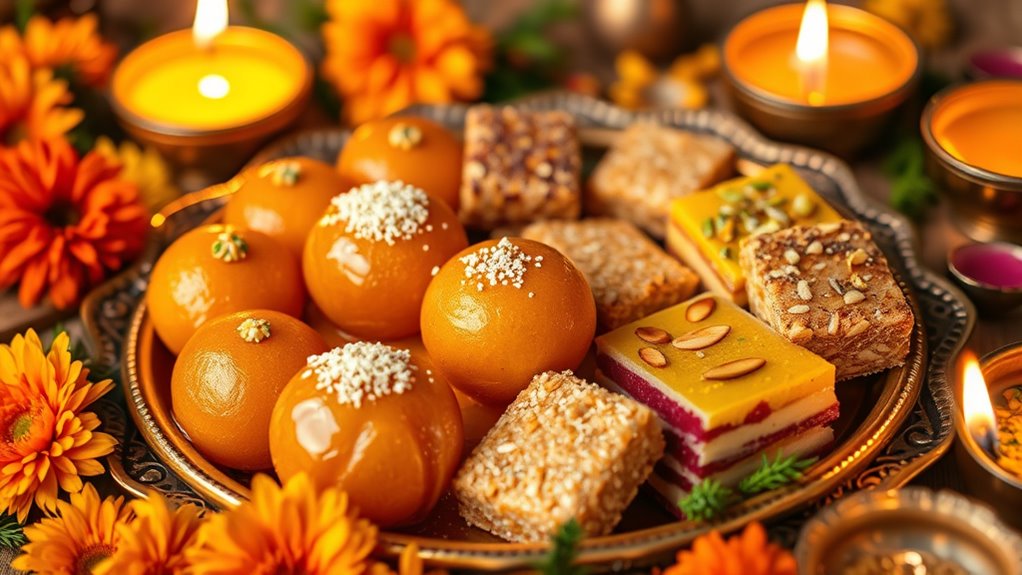
Diwali sweets are crafted using a few key ingredients that give them their distinctive flavors and textures. Milk and its concentrated form, mawa or khoya, create rich, creamy bases for many treats. Flour types like refined wheat flour (maida) and semolina form the structural foundation for sweets like gujiya and shankarpali. Sweeteners include sugar, jaggery, and sometimes syrup, with alternative sweeteners gaining popularity for health reasons. Ghee is extensively used for frying and cooking, adding aroma and crispness. Nuts and dried fruits such as almonds, cashews, and raisins enhance flavor and garnish. Herbal infusions, like cardamom and saffron, elevate the taste, while natural flavorings substitute artificial ones. These ingredients form the core of traditional Diwali sweets, making them rich, aromatic, and festive.
Regional Specialties and Unique Festive Confections

Across India, each region showcases its own unique sweets and confections that add vibrant flavors to the Diwali celebrations. From North Indian Soan Papdi and Gulab Jamun to South Indian Payasam and Mysore Pak, regional specialties create a diverse festive dessert presentation. Rajasthani Ghevar and Bengali Sandesh highlight royal and cultural traditions, while Western treats like Dhokla and Chakli bring a regional twist. These confections often find their way into Diwali gift hampers, adding a personalized touch. To maximize their appeal, you can arrange these sweets beautifully, making each hamper a colorful celebration of regional flavors. Traditional recipes and local ingredients often influence the distinctive taste of each sweet, emphasizing regional culinary heritage. Here’s a snapshot of some regional specialties:
| North India | South India | West India |
|---|---|---|
| Soan Papdi | Payasam | Dhokla |
| Gulab Jamun | Mysore Pak | Chakli |
| Besan Barfi | Coconut Barfi | Mohanthal |
| Punjabi Pinni | Pori Urundai | Malido |
| Gajar Ka Halwa | Coconut Barfi | Gajar Ka Halwa |
Nutritious and Health-Conscious Treats for the Festival

During Diwali, you can enjoy festive treats made with nutritious ingredients like dry fruits, jaggery, and seeds, which add essential nutrients without excess sugar. Many recipes now focus on guilt-free options, replacing refined sugar with natural sweeteners and baking instead of frying. These healthier choices let you indulge while supporting your well-being throughout the celebrations. Incorporating wholesome ingredients not only enhances the flavor but also boosts the nutritional profile of traditional sweets and snacks, making your festival celebrations both joyful and nourishing.
Nutritious Ingredient Choices
Choosing nutritious ingredients for your Diwali treats not only preserves traditional flavors but also boosts their health benefits. Incorporate herbal infusions like tulsi or mint to enhance flavor and provide antioxidant properties. Edible flowers such as marigolds or rose petals add natural color and subtle aroma, making your sweets visually appealing and nourishing. Use whole grains like millet, quinoa, or oats flour to increase fiber and slow down sugar absorption, helping regulate blood sugar and prolong satiety. Nuts and seeds—almonds, flaxseeds, and chia—bring healthy fats, protein, and antioxidants, supporting heart health and satiety. Natural sweeteners like jaggery, honey, or dates reduce refined sugar, while fruits and vegetables like carrot or beetroot boost fiber and antioxidants. Incorporating nutrient-rich ingredients supports overall health and helps maintain energy levels during the festivities.
Guilt-Free Sweet Alternatives
To enjoy guilt-free sweets during Diwali, you can opt for healthier alternatives that satisfy your cravings without compromising your well-being. Using sugar substitutes and healthy baking techniques, you can indulge in treats that are both delicious and nutritious. For example, oats and almond laddoos with jaggery boost fiber and antioxidants, while date and nut barfi offers natural sweetness with added nutrients. Sugar-free carrot halwa made with dates provides sustained energy, and dry fruit laddus with whole nuts eliminate sugar spikes.
| Sweet Option | Key Benefits |
|---|---|
| Oats and almond laddoo | Fiber, antioxidants, reduced glycemic load |
| Date and nut barfi | Natural sweetness, nutrients |
| Sugar-free carrot halwa | Beta-carotene, sustained energy |
| Dry fruit laddus | Healthy fats, minerals |
| Walnut ladoos | Protein, heart health support |
Classic Techniques for Preparing Diwali Sweets
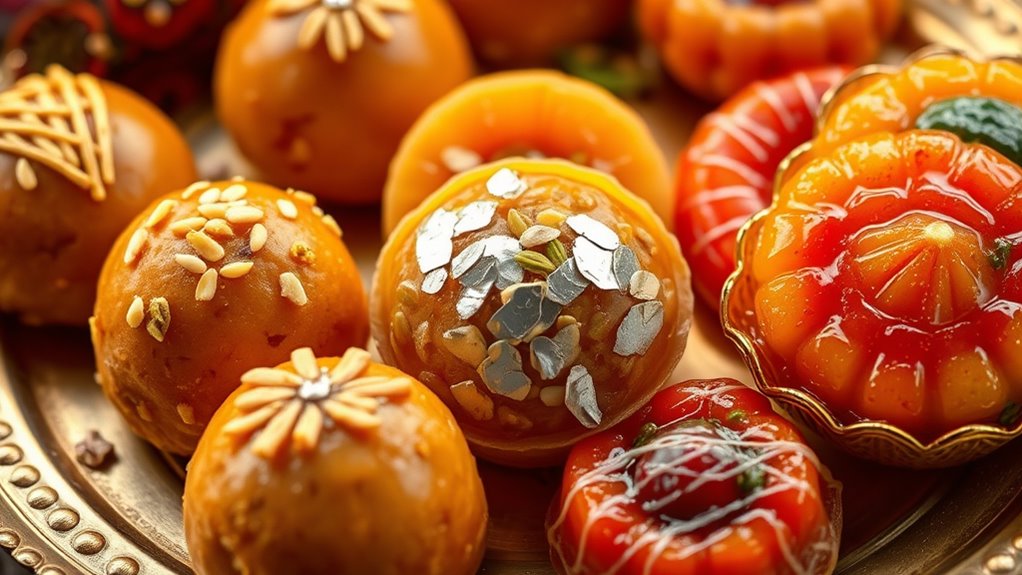
Mastering the art of preparing Diwali sweets involves mastering a few classic techniques that guarantee authentic flavors and perfect textures. First, you’ll want to roast besan in ghee until it releases a rich aroma, removing raw taste before adding sugar. For sweets like kaju katli, ensure your sugar syrup reaches the right consistency—one-string or two-string—so the dough sets perfectly. Slow simmering milk for pedas requires constant stirring to prevent scorching, resulting in a creamy, smooth texture. When shaping, handle warm laddus to keep them soft and cohesive, and roll kaju katli thin for precise diamond cuts. Finally, use festive plating and edible decorations like silver leaf to enhance sweet presentation, making your treats as visually appealing as they are delicious. Food symbolizes joy, prosperity, and life’s sweetness in Indian culture, emphasizing the importance of presentation and aesthetic appeal in traditional sweets.
Perfect Pairings: Sweets and Savories for Celebrations

During Diwali celebrations, sweets often take center stage, but incorporating savory snacks creates a well-rounded and balanced feast. Savory snack pairings like murukku, sev, or khara biscuit add texture and spice, enhancing the flavor contrast techniques that elevate the celebration. These crispy, aromatic snacks refresh your palate between sweet bites and introduce a savory counterpoint to syrupy desserts like gulab jamun or laddus. The balance of spicy, tangy, and crunchy elements with rich, sweet flavors creates a delightful harmony on your plate. Combining dense sweets with dry, crispy savories ensures a multi-sensory experience that’s both satisfying and festive. Savory Snacks play a significant role in elevating the overall festive experience by providing a contrasting flavor profile that complements the sweetness. Incorporating festive culinary traditions can further enhance the celebratory mood. By thoughtfully pairing these items, you craft a memorable feast that celebrates the diversity and richness of Diwali’s culinary traditions.
Storage Tips and Serving Styles for Diwali Desserts
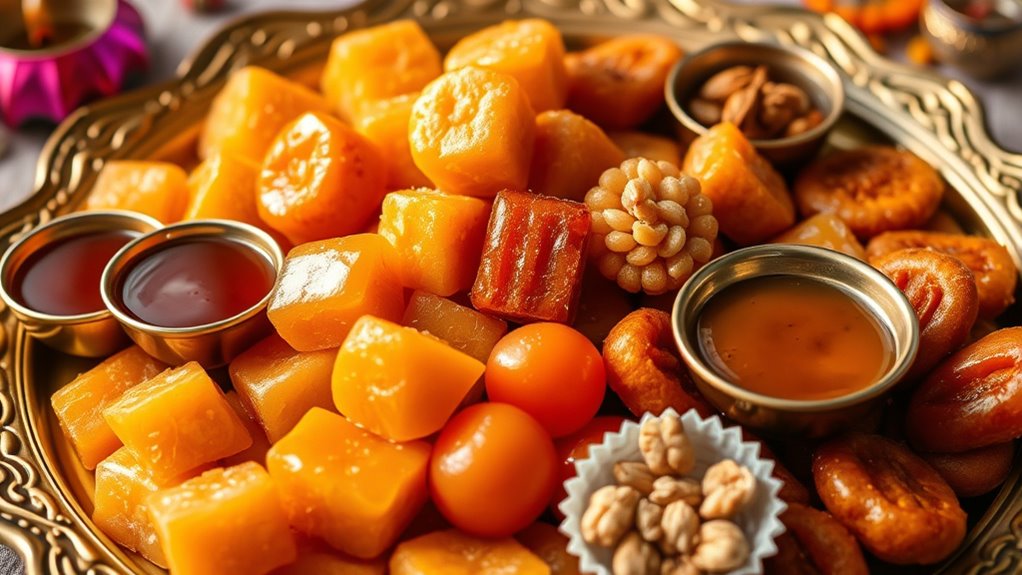
Proper storage and attractive presentation play a key role in maintaining the freshness and appeal of your Diwali sweets. Use airtight glass or BPA-free containers for milk-based mithai to prevent flavor loss, and store dry sweets in metal tins lined with parchment paper to keep their texture. Layer sweets with parchment to avoid sticking and preserve shape. Keep moist and dry varieties separate using moisture-proof seals or different compartments, and avoid humidity sources. For long-term storage, freeze sweets like laddus in airtight containers, and label with freeze dates. When serving, present refrigerated sweets at room temperature to enhance flavors. Use innovative presentation techniques like decorative liners, traditional dishes, and edible garnishes like silver foil or nuts. Opt for eco-friendly packaging to add a thoughtful touch to your festive feast. Additionally, choosing appropriate storage conditions such as controlled temperature and humidity can significantly extend the shelf life of your sweets.
Creative Variations and Modern Twists on Traditional Favorites

Creative twists and modern interpretations breathe new life into traditional Diwali sweets, making them appealing to contemporary palates. You can explore innovative flavor combinations like merging classic Indian ingredients with Western techniques, such as Rasmalai Tres Leches or Kulfi Tres Leches Cupcakes. Fusion presentation styles elevate these treats, like the Gulab Jamun Cake, which balances syrupy softness with airy sponge, or the rose-flavored French tart that blends Indian floral notes with elegant pastry. Other inventive options include Chocolate Jalebi Bark and Gajar Ka Halwa Truffles, offering familiar flavors in trendy formats. Incorporating regional culinary heritage into these modern creations can deepen their cultural significance, blending tradition with innovation. These modern variations retain the essence of tradition while appealing to new tastes, making your Diwali celebrations both nostalgic and innovative.
Frequently Asked Questions
What Are Some Regional Variations in Diwali Sweet Recipes?
You’ll notice that regional ingredients and cultural influences shape Diwali sweet recipes differently across India. In North India, milk-based sweets like Gulab Jamun and Kaju Katli are popular, while South Indian desserts like Paruppu Payasam feature coconut and jaggery. Eastern regions favor chhena-based sweets like Rasgulla, and Western India prefers ghee-rich treats like Mysore Pak. These variations reflect local flavors, ingredients, and traditions, making each region’s sweets uniquely special.
How Can I Make Diabetic-Friendly Diwali Sweets?
To make diabetic-friendly sweets, you should focus on using sugar substitutes like stevia and date paste, which lower sugar content. Incorporate low glycemic ingredients such as sweet potatoes, ragi flour, and quinoa flour, and practice portion control to prevent spikes. Baking or air frying instead of deep-frying preserves nutrients. These methods help you enjoy festive treats while managing blood sugar effectively.
Which Ingredients Are Best for Vegan Diwali Desserts?
You can make vegan Diwali desserts using plant-based sweeteners like jaggery or date syrup to keep them naturally sweet. Swap dairy ingredients with plant-based options such as almond milk, coconut milk, or cashew cream for richness. Use chickpea flour, nut flours, and gluten-free flours as bases. Incorporate nuts, dried fruits, and spices to enhance flavor, ensuring your sweets are both delicious and vegan-friendly.
How Do I Achieve the Perfect Texture in Ladoos?
Getting the perfect ladoo texture is a fine art—you need to hit the sweet spot. Use proper ladoo rolling techniques to shape evenly, and make certain your sugar syrup reaches the right consistency, whether one-string for soft ladoos or two-string for firmer ones. Mix in roasted ingredients, keep the mixture warm, and shape while still manageable. Rest the ladoos to set, and you’ll have uniform, melt-in-your-mouth treats every time.
Are There Gluten-Free Options for Traditional Diwali Sweets?
You can enjoy gluten-free options for traditional recipes by using gluten-free flours like almond flour, chickpea flour, or tapioca starch. These ingredients help you recreate classic sweets such as gulab jamun, besan laddoos, and mysore pak without wheat. By swapping in gluten-free flours, you preserve authentic flavors and textures while accommodating dietary restrictions, making your celebrations inclusive and delicious.
Conclusion
As you explore these Diwali delights, imagine yourself as a master chef painting a vibrant tapestry of flavors. Each sweet and savory is a brushstroke, adding warmth and color to your celebration. Embrace tradition while adding your own creative splash, turning your festival feast into a masterpiece. With every bite, you’re weaving memories and joy, creating a delicious mosaic that lights up your Diwali just like the festival of lights itself.
